The iSMA-B-FCU device can work with single cooling device (1st stage only) or with two cooling devices (basic, 1st stage, and additional, 2nd stage). The type of operating stages is chosen with the S3 CFG DIP switch number 3.
1 Stage Cooling
For the 1st stage only, depending on control mode, the user can choose 1 of 3 outputs:
-
A2, in 4-pipe mode analog output (only analog control mode);
-
A1, in 2 pipe mode analog output (only analog control mode);
-
TO2, in 4-pipe mode triac output (digital and analog control modes);
-
TO1, in 2-pipe mode triac output (digital and analog control modes);
-
O5, relay output (only digital control mode).
The connections of heating devices, in this example in iSMA-B-FCU-HH, are presented in the figure below.
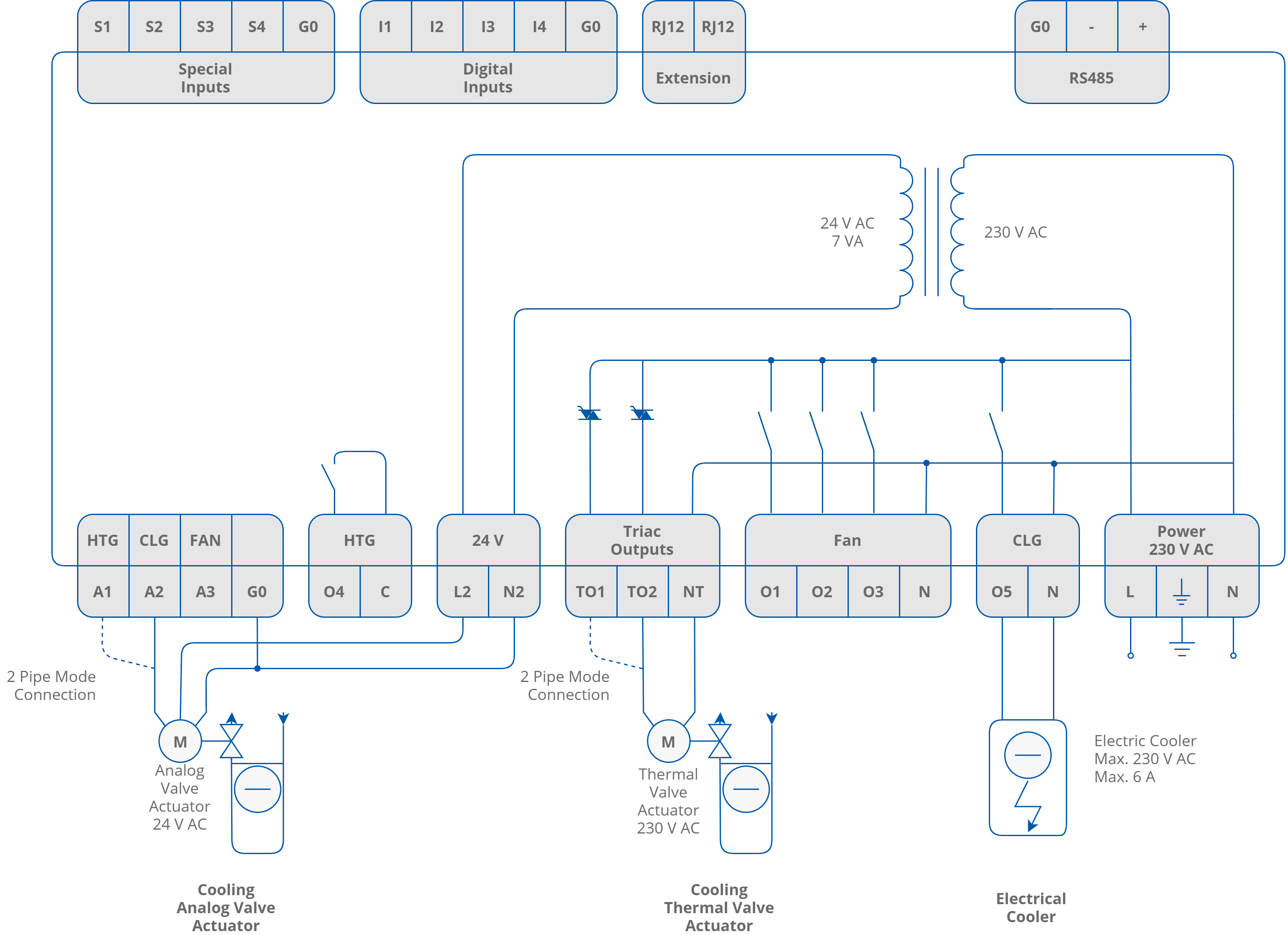
Example connections of FCU-HH cooling devices
Note: The O5 CLG output relay can be enabled/disabled with the CLG_Relays_Enable network parameter; by default this relay is enabled.
Note: In 2-pipe mode, cooling and heating signals are on the same outputs, A1 and TO1.
Digital Control Mode
In this mode, the control algorithm works as a typical thermostat, basing on the Effective Setpoint and Control Value with heating Diff parameters defined in the Cooling_Binary_Diff network parameter. The output signal works in 2 states, low and high. In the 1st stage cooling only, the user can choose 1 of 2 outputs: TO2 (or TO1 in 2-pipe mode) triac output or O5 relay output. The A1 and A2 outputs are disabled. The high value of the thermostat output also activates the fan. The digital control mode algorithm of cooling is presented in the chart below.

The CFG DIP switch configuration for digital control mode
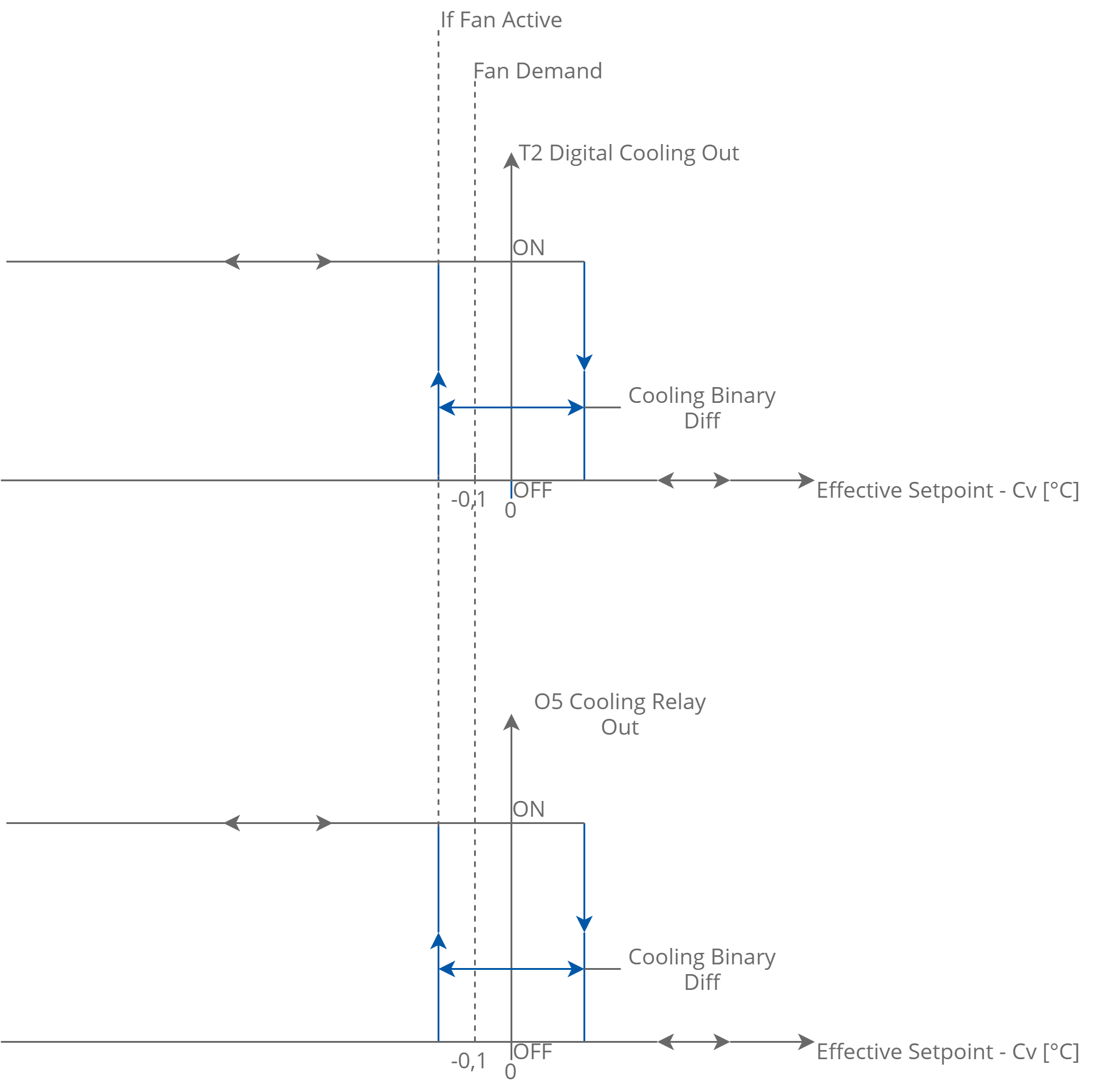
1 stage cooling digital control mode
Note: In the 2-pipe mode (CFG DIP switch number 1 in on position), cooling and heating signals are on the same outputs, A1 and TO1.
Note: The O5 CLG output relay can be enabled/disabled by the CLG_Relays_Enable network parameter; by default this relay is enabled. If the output is not in use, it is recommended to disable it.
Analog Control Mode
In this mode, the algorithm is controlled with the PI regulator, which calculates the output value in the range from -100% to 0 basing on the Effective_Setpiont and CV (room temperature) values. The PI regulator can be adjusted with network Kp and Ti parameters network. In the 1st stage cooling, the user can choose 1 of 2 outputs: A2 (or A1 in 2-pipe mode) analog output or TO2 (or TO1 in 2-pipe mode) triac output PWM. The O5 relay output is disabled. The analog output value and triac PWM signal are proportional to the PI regulator output. If the PI regulator output is equal or higher than 5, the fan is activated. The analog control mode algorithm of cooling is presented in the charts below.
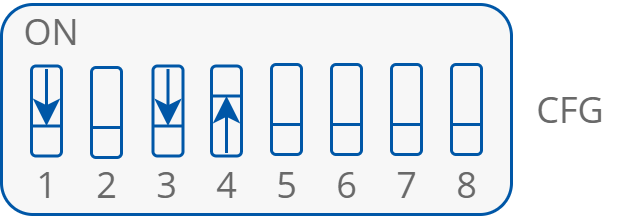
The CFG DIP switch configuration for analog control mode

1 stage cooling analog control mode
2 Stage Cooling
As an additional 2nd stage cooling, the default application can operate only with the O5 relay. The 2nd stage cooling is enabled with the CFG DIP setting (switch number 3 in on position).
The connection and the 2nd stage activating the CFG DIP switch in high voltage version are presented in the figure below.
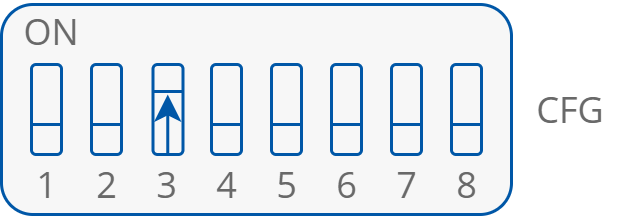
2 stage cooling DIP switch configuration
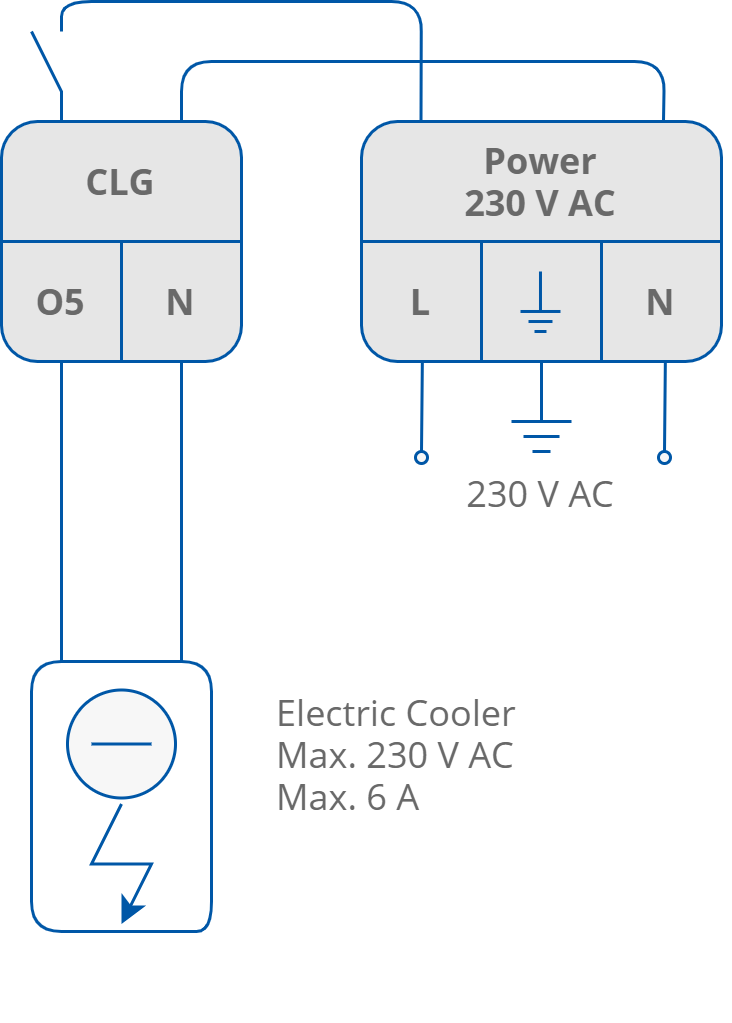
Configuration of the 2nd stage electrical cooler and the 2nd stage of cooling activating CFG DIP switch
Note: In iSMA-B-FCU-HH and iSMA-B-FCU-HL this high state the output has 230 V AC, in iSMA-B-FCU-LL the high state output is 24 V AC.
Digital Control Mode
In this mode, the control algorithm operates with 2 typical thermostats. The 1st stage thermostat is based on the Effective Setpoint and Control Value with cooling Diff parameter defined in the Cooling_Binary_Diff network variable. The 2nd stage thermostat works with shifted Effective Setpoint and Control Value with cooling Diff parameters defined in the Second_Stage_Diff_Binary network parameter. The 2nd stage setpoint shifting value is defined in the Second_Stage_Threshold_Binary network variable. The 1st stage thermostat output high value also activates the fan. The output signals operate in 2 states, low and high. In the 1st stage cooling, the user can only use TO1 triac output, and in the 2nd stage only the O5 relay output. A1 and A2 outputs are disabled. The digital control mode algorithm of the 2nd stage cooling is presented in the chart below.
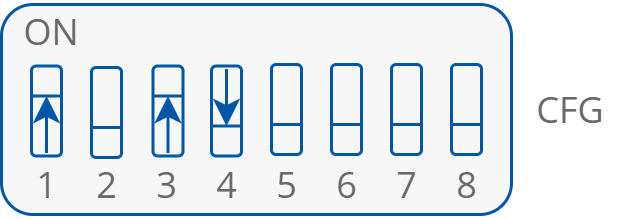
The CFG DIP switch configuration for digital control mode

2 stage cooling digital control mode
Analog Control Mode
In this mode, the algorithm is controlled by the PI regulator, which calculates the output value in the range from -100% to 0, basing on the Effective_Setpoint and CV (room temperature) values. The PI regulator can be adjusted by network parameters Kp and Ti. The 1st stage analog signal is scaled to Second_Stage_Threshold_Analog network parameter. In the range from 0 to Second_Stage_Threshold_Analog, the analog signal is proportional to PI regulator output in range from 0 to 100%. If the PI regulator output is equal or higher than Second_Stage_Threshold_Analog, the analog signal value is set to 100%. The 2nd stage works as a thermostat, basing on the Second_Stage_Threshold_Analog as Setpoint, the PI regulator output as Control Value and Diff parameters defined in the Second_Stage_Diff_Analog network parameter. In the 1st stage cooling, the user can choose 1 of 2 outputs: A2 analog output or TO2 triac output PWM. The O5 relay output is dedicated to the 2nd stage. The A2 analog output value and the TO2 PWM signal is proportional to the PI regulator output. If the PI regulator output is equal or higher than 5%, it activates the fan (Fan Demand). The analog control mode of the 2nd stage cooling is shown in charts below.
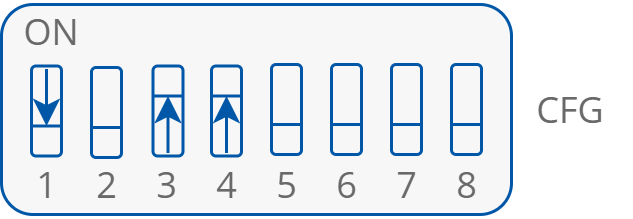
The CFG DIP switch configuration for analog control mode
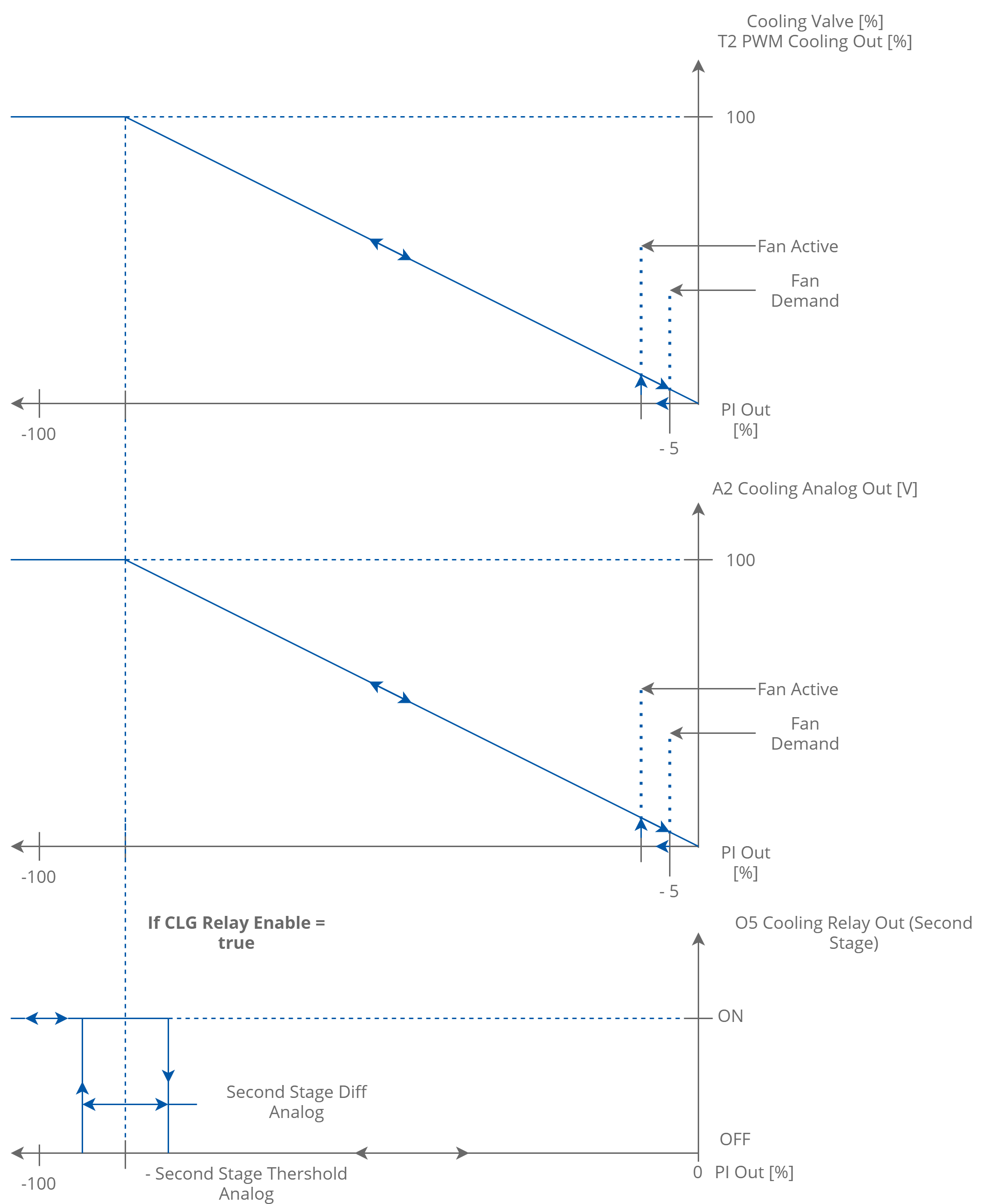
2 stage cooling analog control mode
